 Mini Review
Mini Review
Insect Pest Guide
Nathan Hermond*
Extension Associate, College of Agriculture and Human Sciences, Prairie View A&M University, USA.
Corresponding AuthorNathan Hermond, Extension Associate, College of Agriculture and Human Sciences, Prairie View A&M University, USA.
Received Date:July 24, 2023; Published Date:August 21, 2023
Turf and Pasture Pests
Armyworms (Noctuidae)
Moth larvae are major chewing pests of turf and grains. There are several species of these caterpillars, including the Fall Armyworm and the Spring Armyworm. All are semi-social agricultural and garden pests (Figure 1).

• Life Cycle: Overwintering pupae molt in spring, adult
moths lay masses of eggs on host plants (mainly grasses),
4-week larval feeding period before becoming pupae. There are
multiple generations yearly.
• Behavior: Caterpillars travel in groups to seek out new
food sources (hence the name armyworms), skeletonize leaves
as young larvae and devour entire leaves and stems as larger
larvae, cause brown spots in lawns.
• Food Source: Grains, corn, turfgrass, plants with thick
canopies are especially susceptible.
• Management: Parasitoid wasps, lacewings devour
caterpillars and other pests [1].
Grasshoppers (Acrididae)
Chewing insects of many plant species including weeds and grasses. Grasshoppers can grow in population during warm and dry seasons and therefore pose a threat to grasses and agricultural plants. Since there are many grasshopper species, there is a wide range of preferred food. Grasshoppers have nymph stages which are smaller grasshoppers that lack wings (Figure 2).

• Life Cycle: During spring, eggs are laid on the undersides
of crop leaves, in grasses and in weedy fields and hatch into
nymphs which feed on the plants. Nymphs molt and become
pupae in the soil before hatching into adults. There is 1
generation yearly.
• Behavior: Able to migrate quickly to new plants. While not
social, grasshoppers live in large “communities” that include
multiple species. They communicate with their wings and hind
legs, making loud noises audible to humans.
• Food Source: Grasses, weeds, pumpkins, squash,
sunflower, corn, grains, tomatoes, sweet potatoes, etc.
• Management: Lacewings eat grasshoppers. Pesticide
application may be necessary to control large populations
during dry seasons. Grasshoppers can kill plants by eating all
the vegetation and stems. Apply insecticides to the undersides
of plant leaves [2,3].
Red Imported Fire Ants (Formicidae)
Eusocial pest insects of urban developments, fields, pastures and farms. Fire Ants are most active during warm months, even when it is dry. They build large communal mounds that block harvesting tools, disrupt power technology, and break electrical machinery that are used as mound sites. Fire ants are attracted to electrical currents (Figure 3).
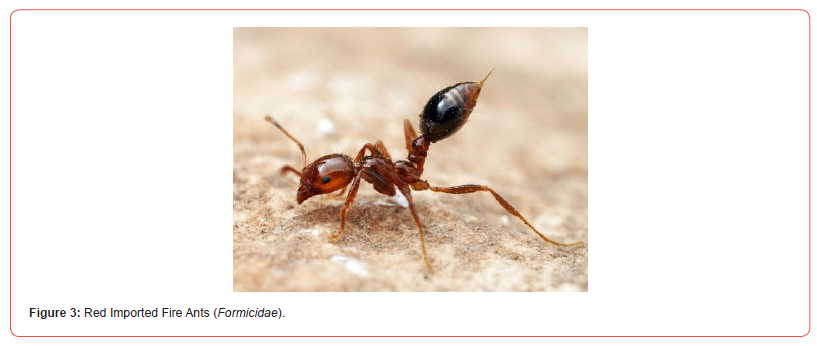
• Life Cycle: The queen lays up to 1000 eggs daily, which
become tiny larvae to which the workers tend. After pupating,
they either become reproductive adults (including new queens
and male drones), or female workers.
• Behavior: Aggressive. They will bite and sting any object
that enters their nest using formic acid to produce a fiery
burn. Works gather soil and begin digging tunnels to produce
a mound. Mounds continue to grow and become large obvious
piles. The tunnels reach down to the water table. Many workers
forage outside of the hive to scout for enemy ants and find food.
• Food Source: Human food, other insects including ants,
seeds, nuts, fruits, very small lizards and even birds, carcasses.
• Management: Apply a dry pellet type pesticide that the
ants ingest and kills the queen. With larger populations or
farm/garden operations, use a powder that is mixed with water
through a sprinkler system to spray the field and eradicate the
fire ants [3].
Bermudagrass Stem Maggot (Muscidae)
Fly larva pest of Bermudagrass and Stargrass. The fly is native to Asia but appeared in the United States in 2010. The fly is small and yellow (Figure 4).

• Life Cycle: Eggs are laid on Bermudagrass. After hatching,
the larva migrates to the upper stem shoot, where it burrows
and begins devouring stem material. The top leaves of the grass
die off, but the remainder of the plant remains green. After
feeding is complete, the maggot emerges and drops to the earth
to pupate. The fly emerges from the ground. It takes around 2.5
weeks for the life cycle to complete.
• Behavior: Maggots create a tunnel in the stem, below the
dead leaves. The maggot may be seen if this part of the plant
is opened. Maggots do not usually infest grazed pasture, since
they are eaten by the livestock with the grass.
• Management: Grazing. Harvest the grass during the
larval stage which will kill the maggots. Apply an insecticide to
prevent adult flies from emerging and laying new eggs [4].
Timber and Grove Pests
Pecan Nut Casebearer (Pyralidae)
Caterpillar of small plain moth which feeds on pecan nuts and buds. It is found in all Pecan growing areas of Texas and eastern New Mexico. The Casebearer is an extremely deadly pest of pecans, especially considering that damage is done to the pecans themselves, the economically important plant product (Figure 5).
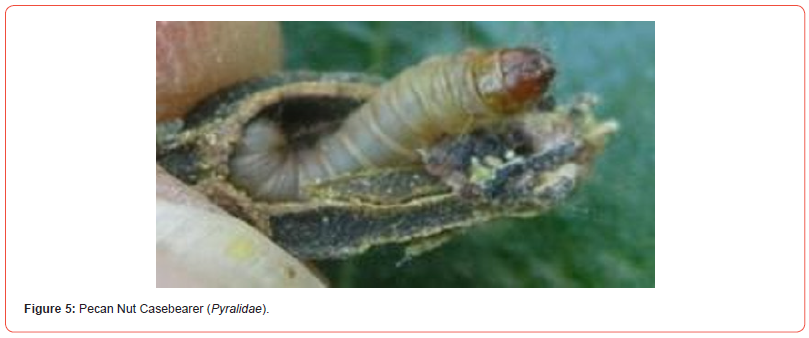
• Life Cycle: Around 100 eggs laid on pecan nuts, which
hatch after 4 days. The larvae eat buds for 2 days then move
to the pecan nutlets to feed. Caterpillars burrow into nuts to
become pupae then adults. There are 2 generations yearly.
• Behavior: Burrow into pecan nuts (causing damage to
the economically important product). The larvae leave silk and
frass near infested nuts.
• Food Source: Pecan buds and nuts
• Management: Pheromone traps determine population,
insecticide application before the larvae enter the nuts (soon
after hatching) [5].
Emerald Ash Borer (Buprestidae)
One of the jewel beetles, known for their bright color, the EAB feeds only on ash and causes many deaths. Their larvae create visible tunnels in the bark of ash trees. Adults eat leaves and do minimal damage (Figure 6).
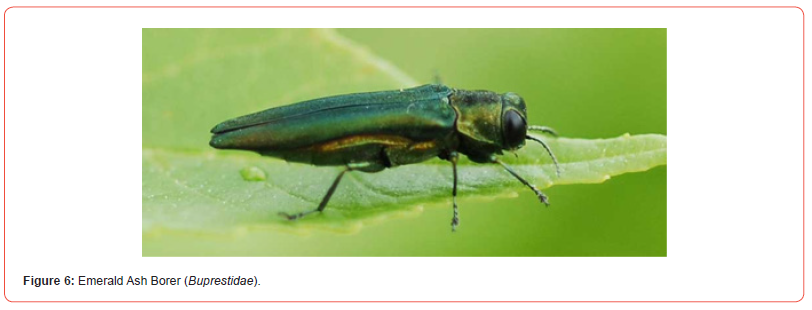
• Life Cycle: Adults feed on ash leaves and mate, before
laying eggs in the bark of ash trees. Larvae hatch and tunnel
into the barkwhere they devour nutrients and weaken the trees
severely. Adults emerge through D shaped holes.
• Behavior: Tunneling larvae. Adults do little to no damage.
• Food Source: Xylem and phloem of ash trees.
• Management: Timed pesticide application during mating/
egg laying. Must be applied before larvae enter the trees [6].
Codling Moth (Tortricidae)
The number 1 pest of fruits including apples and pears. A dusky brown moth whose larvae feed on fruit flesh. The larvae are light pink with brown heads (Figure 7).

• Life Cycle: Larval cocoons overwinter in the soil or on tree
bark. The larvae pupate inside the cocoon and emerge as adults
during early to mid-spring. Adults lay around 30 small eggs
on leaves, branches and fruits/nuts, where larvae hatch and
burrow into the fruits.
• Behavior: Burrowing larva. The larvae leave holes in
the apples and pears and leave frass inside the fruits. Larvae
develop more quickly in warm climates, resulting in more
generations.
• Food Source: Apples and pears
• Management: Codling moths must be managed when the
population is small to prevent increased generations. It is best
to apply pesticides or beneficial insects during the egg stage or
just as larvae are hatching [7].
Horticulture Pests
Squash Bug (Coreidae)
Known as leaf footed bugs for their enlarged hind legs. Squash bugs are major pests that migrate from squash to other nearby plants. They are sucking insects which are harmful to all plants since a large community can drain plants of nutrients. They are found in communities of adults and nymphs living together (Figure 8).
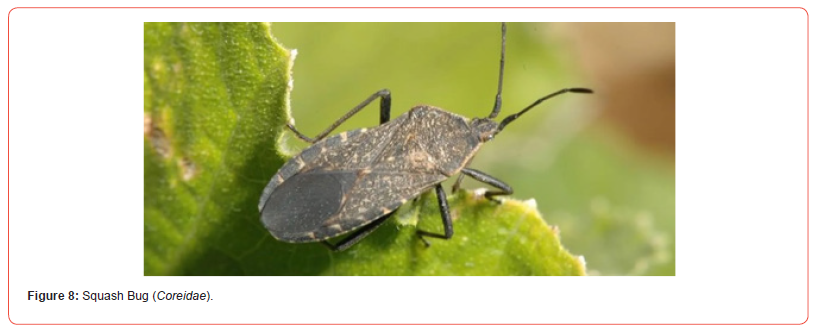
Life Cycle: Eggs are laid in clusters on squash and pumpkin
leaves and stems. After hatching, nymphs stay in groups and
suck the nutrients from plants. Adults stay on plants near the
young bugs to feed.
• Behavior: Will attempt to bite. Squash bugs will rest on
the floor under plants and hide under leaves to remain hidden.
• Food Source: Squash, pumpkins, sunflowers
• Management: General insecticide application, especially
during egg laying [8].
Tomato Hornworm (Sphingidae)
Larvae are highly voracious and destructive tomato pests. These emerald, green caterpillars grow in size quickly and completely defoliate young tomato plants and consume enough leaves on large plants to cause wilting. The caterpillars primarily ingest leaves and stems, but also harm tomato fruits, making them additionally undesirable since the fruits cannot be sold or used (Figure 9).
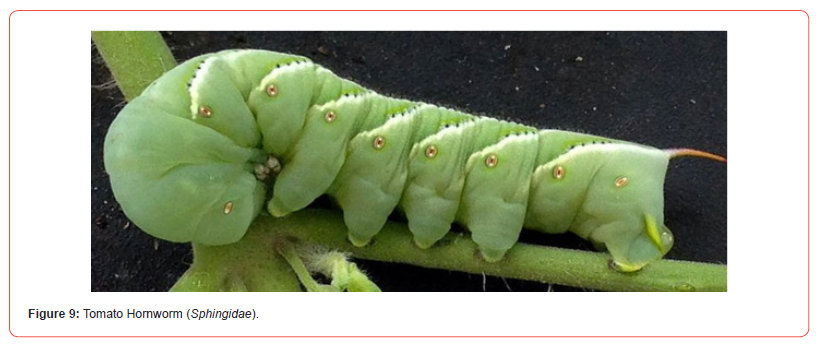
• Life Cycle: During spring and summer, overwintering
adult moths lay eggs in clusters on tomato leaf undersides. The
larvae hatch and immediately attack tomato leaves. There are
4 to 5 instars. Larvae drop to the ground to pupate and adults
hatch in the fall before overwintering.
• Behavior: Caterpillars are semi-aggressive and may
attempt to bite when handled. They are usually found on the
stems and branches of tomato plants.
• Food Source: Tomato family plants including eggplant and
potato.
• Management: Release parasitoid wasps (Braconidae,
Sphecidae, Ichneumonidae) which use these caterpillars as
a food source for their many eggs. Set up pheromone traps to
keep adults from reproducing. Use pesticides sparingly since
tomatoes host beneficial wildlife [9].
Cucumber Beetle (Chrysomelidae)
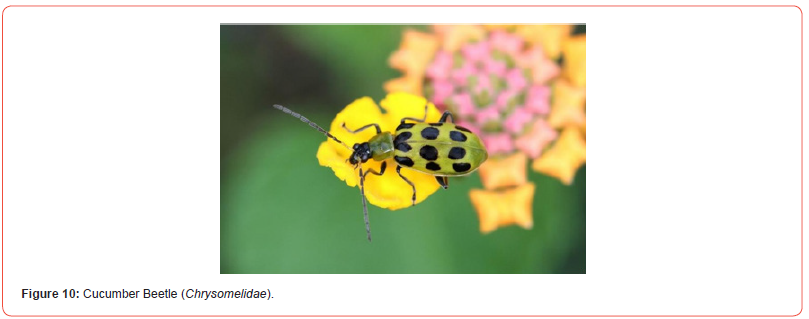
As a member of the leaf beetle family, cucumber beetles spend
much of their time on the underside of vegetable leaves. A chewing
pest of cucurbits, they can be found in large numbers during late
spring and summer. They can be mistaken for lady beetles due to
their green and spotted or striped wings. The larvae are corn pests.
They can spread fecal bacteria to the plants known as bacterial wilt
(Figure 10).
• Life Cycle: After overwintering in weedy fields, adults
move to gardens and farms when plants begin to emerge. They
lay eggs in the soil or at the base of the plant. After hatching,
larvae feed on corn roots for a few weeks before pupating then
emerging as adults which feed on plants above ground.
• Behavior: Beetles are attracted to feeding stimulants
released by their host plants near the buds and new leaves.
This results in a bigger infestation. Adults also attack cucumber
fruits.
• Food Source: Corn roots as larvae, cucumbers and similar
plants as adults, including sweet potato. Adults will eat flower
heads.
• Management: Soldier beetles, some parasitoid flies and
wasps, insect pathogens, trap crops, insecticides that modify
behavior, feeding hormones (to attract the beetles to weeds or
non-host plants) [10,11].
Aphids (Aphididae)
Semi-social sucking pests of many flowers, shrubs and trees. They drain plants of their nutrients and prevent beneficial insects from using plants as a food source. They are used as “livestock” by ants, including fire ants, which also are pests (Figure 11).
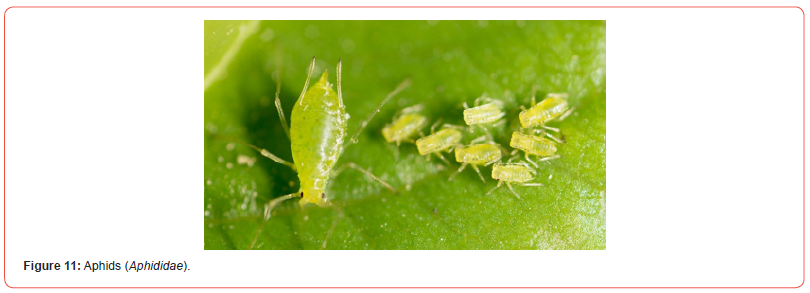
• Life Cycle: Adult females lay eggs near the colony on
branches/stems and leaves in spring and summer. Eggs hatch
into nymphs which grow as they feed and live with the adults.
Nymphs are smaller copies of adult aphids. They eventually
molt and grow into adults, with females gaining wings and
mating.
• Behavior: Live in colonies. They allow ants to tend to
them, providing their waste in the form of honeydew, a sweet
secretion which ants use as food.
• Food Source: Plant juices and nutrients. They feed on a
wide variety of crops, flowering plants and trees, including fruit
and nut trees. There are aphids that primarily attack pecans
and cause leaf discoloration.
• Management: Lady beetles are available for purchase, and
both the larvae and adults will eradicate aphid populations in
agricultural and garden settings. Insecticide soaps, and acidic
pesticides are effective methods [12].
Colorado Potato Beetle (Chrysomelidae)
Considering our range of ten legume species, CO2-C derived from residue mineralisation during soil incubation was on average higher for shoots (62.7%) compared to root residues (47.8%) (F(1,74)=49.4, p < 0.001) (Figure 1). Legume species had a significant effect on shoot residues C mineralisation at the end of incubation (i.e.112 days) (F(9,30)=12.2, p < 0.001) with values ranging from 41.8 to 77% for Narbonne vetch and pea, respectively (Figure 1A). At the end of incubation, root C mineralisation ranged from 33.5to 59.2% with a significant effect of species (F(8,27)=22.0, p < 0.001). Chickpea, faba bean and soybean had the highest root residues C mineralisation while lentil and Narbonne vetch had the lowest (Figure 1B).

Insect pests in the leaf beetle family. Adult beetles are golden
yellow with white and black striped wings. They are dome-shaped
and feed on potato leaves but will migrate to plants that are related
to potatoes, including tomatoes and eggplants (Figure 12).
• Life Cycle: After overwintering underground in fields and
gardens, adults appear when potato plants emerge (Spring),
laying their egg masses under leaves. When the larvae hatch
after 2 weeks, they are humpbacked and dark red with black
heads and spots on their sides. They feed on the leaves all over
the plant, defoliating plants completely as they grow in size.
Fully grown larvae are bright red or salmon pink. Larvae take
about 10 days to complete development if temperatures are
I the 80’s during their feeding. The final instar larvae burrow
into the soil to pupate, before hatching into adults. Fall adults
will overwinter.
• Behavior: Semi-social insects that stay clustered but
disperse as they feed.
• Food Source: Potatoes, tomatoes, eggplants, nightshade.
• Management: Remove weeds in the nightshade family
that serve as hosts for larvae to weaken the population. Grow
varieties of potato plants that mature quickly to mitigate the
damage caused when beetles feed on young plants. Alternate
crops with a plant on which the Potato Beetles do not feed.
Incorporate their natural enemies including stinkbugs and lady
beetles [13].
Acknowledgement
None.
Conflict of Interest
No conflict of interest.
References
- Capitol Technology University (2022) Learn, Build, Succeed. p.1.
- President Biden J (2021) The White House Letter, Washington.
- Ide, lopez, Frohlich, Scheffran (2021) Pathways to water conflict during drought in the MENA region. Journal of Peace Research, pp. 568-582.
- Mena (2021) The costs of Municipal Water Supply in Bahrain, Revising Bahrain's municipal water terrific structure help conserve water, enhance cost recovery and contribute to achieving social equity among water consumers.
- United Nations Climate Change (2021) What is the United Nations Framework Convention on Climate Change.
- Cui Y, Ma Qingfen, Wu ZHongye, Lu H, Gao Z, et al. (2021) A hydrostatic Pressure- Driven Desalination System for Large –Scale Dee Sea Water Space Station. International Journal of Chemical Engineering, p.1.
- Schulkes (2021) Mega-projects and Small Enterprises: Understanding Saudi Arabian Banks’ Role in Economic Development. Middle East Institute, Washington DC.
- Mc Kuin, Zumkehr Ta, Bales Viers, Pathak Campbell (2021) Energy and water co-benefits from covering canals with solar panels. Sierra Nevada Research Institute, University of California Merced, Environmental Studies Department, University Santa Cruz, p.1.
- GWI (2020) Atmospheric Water Generation. Vol 21, Issue 5.
- SOURCE (2021) SOURCE Hydropanels.
- International Bank for Reconstruction and Development (IBRD) (2021) Fiera Capital invests in World Bank Sustainable Development Bonds and Risks Awareness for the Importance of Water and Ocean Resources.
- Adams A (2018) Ocean Swarms Revealed. Stanford Woods Institute for the Environment. Stanford University.
- Ghernaout D (2017) Reverse Osmosis Process Membranes Modeling - A Historical Overview. Journal of Civil, Construction of Environment Engineering.
- Korea Development Institute (2018) Preliminary Feasibility Study (PFS), Public and Private Infrastructure Investment Management Center, Public and Private Infrastructure Investment Management Center, pp.1-9.
- Faudot A (2019) Saudi Arabia and the rentier regime trap: A critical assessment of the Vision 2030. RUDN University, Moscow, Russian Federation: Universite, Grenoble Alpes, France, Elsevier, pp. 1-22.
- Petriat P (2021) The Uneven Age of Speed: Caravans, Technology, and Mobility in the Late Ottoman and Post-Ottoman Middle East. Cambridge University Press, p.273.
- Gulf Construction (2021) Dual Challenge. Saudi Arabia, pp.1.
- Suwaileh, Hilal, Pathak, Shon (2020) Forward osmosis membranes and processes: A comprehensive review of research trends and future outlook. Engineering Advance 485: 114455.
- Randolph J (2009) Practical Assessment, Research, and Evaluation. Walden University 14(13): 4,5.
- Randolph JJ (2009) Practical Assessment Research & Evaluation. Walden University 14(13): 1,4,5,11.
- Service R (2020) Russia and American Power in the Middle East, Board of Trustees of Lei and Stanford Junior University. p.1.
- Mumssen VY, Triche T, Sadik Dirioz (2017) Status of Water Sector Regulation in the Middle East and North Africa. The World Bank, p.12.
- Koch N (2021) Desert geopolitics: Arizona, Arabia, and an arud-lands response to the territorial trap. Duke University, Academia, pp. 1-101.
- The Red Sea Development Company (2021) The Red Sea Development Company and Source Global, PBC join forces to set new standards for sustainable water. p.1.
- Whitefield CR (2021) Solar Thermal Hot Water for Hotels. Academia Letters, pp. 1-8.
- Dunn J (2021) Marketing Coordinator.
- Bloomberg (2021) Norways $1.4 trillion wealth fund set to get strict Co2 Sovereign Wealth Funds.
- Dai L (2021) Implementation Constraints on Israel- Palestine Water Cooperation: An Analysis Using the Water Governance Assessment Framework. 13(5): 620.
- Academic Review Checklist (2021) ARB Document. Capitol Technology, pp.1.8.
- Revilla MLD, F Qu, KE Seetharam, B Rao (2021) Sanitation in the Top Development Journals: A Review. ADBI Working paper 1253, Tokyo:Asian Development Bank Institute. p.2.
- Alsulami SM (2021) US-China Competition and Its Implications for the Middle East. International Institute for Iranian Studies (Rasanah).
- Tamosaitiene J, Sarvari H, Chan DWM, Cristofaro M (2020) Assessing the barriers and risks to private sector participation in infrastructure construction projects in developing countries of Middle East. Sustainability 13(153): 1-20.
- Akomea-Frimpong Jin, Osei-Kyei (2021) Managing financial risks to improve financial success of public-private partnership projects: a theoretical framework. School of Engineering, Design and Built Environment, Western Sydney University, Sydney, Australia, p.2.
- Al-Masari AR, Spyridopoulos T, Karatzas S, Lazari V, Tryfonas T (2021) A Systems Approach to Understanding Geopolitical Tensions in the Middle East in the Face a Global Shortage. University of Surrey, UK, Toshiba Research Europe, Ltd, UK, University of Patras, Greece, University of Bristol, UK, p.2.
- Linares VR, Li Z, Sarp S, Bucs S Sz, Amy G, et al. (2014) Forward Osmosis Niches in Seawater Desalination and Wastewater Reuse. King Abdullah University of Science and Technology, Water Desalination and Reuse Center, Thuwal, Saudi Arabia Delft University of Technology, Faculty of Applied Sciences, Department of Biotechnology, Delft, The Netherlands, GS Engineering & Construction, Environmental Process Engineering Team, Grand Seoul Building 33, Jongno-gu,Seoul, Republic of Korea, p. 135.
- Creswell WJ ( 2009) Research Design, Qualitative, Quantitative, and Mixed Methods Approaches, Third Edition, Sage, p.14.
- Swvl Inc (2021) SWVL completes pre-funding of $35.5 million of pipe to accelerate growth strategy. Securities Exchange Act, p.1.
- Abu Dhabi Investment Council (2022) Welcome to the Council where we execute sound Investment strategies today for capital growth and Abu Dhabi’s secure future tomorrow. p.1.
- AbuA-Foul (2022) Whose Water? The Jordon Water and Continuing Challenges, Bu Nehir Kimin? Urdun Nehrive Suregelen Zorluklaer, p.1.
- Abed G, Zhang T (2018) Saudi Arabia: Diversification Requires Deep and Sustained Structural Reforms. Institute for International Finance, pp.1-22.
- Arab News (2021) Saudi National Water Company Signs Two Contracts with $154m. Arabnews.com p.1.
- Basyariah N, Kusuma H, Qizam I (2021) Determinants if Sukuk Market Development: Macroeconomic Stability and Institutional Approach. Journal of Asian Finance, Economics and Business 8(2): 0201-0211.
- Bayrak P (2021) Abraham Accords: Palestine issue should be addressed for a peaceful Middle East. University of London, United Kingdom, 1.
- Birkin M, Procter R, Allan R, Bechhofer S, Buchan I, et al. (2010) Philosophical Transaction of the Royal Society A Mathematical Physical Engineering Science, Evolution in Computational Intelligence. Springer, p.1.
- Boyd STM (2019) Quantitative Flux Coupling Analysis. Journal of Mathematical Biology, p.1.
- Emirates Nuclear Energy Corporation (2021) Generating Clean Energy.
- Sevincer T, Kwon YJ, Varnum EWM, Kitayama S (2021) Risky Business: Cosmopolitan Culture and Risk-Taking. 52: 252.
- Dean (2021) Academic Review Results.
- Dixon DA, Monk HBA (2011) The Design and Governance of Sovereign Wealth Funds: Principles & Practices for Resource Revenue Management. University of Bristol, Stanford University, p.1,3.
- EWEC (2022) Staying ahead of the current.
- Journal of Civil, Construction and Environmental Engineering. Science Publishing Group.
- Genovese W (2014) The Enterprise technology Framework as Applied to Cloud Initiatives. IBM, p.1.
- Gifford C (2020) Blurred Vison. World Finance, p.1.
- Hannah Ritchie, Roser M (2020) Energy. p.1.
- Google Scholar (2021) Best practices in exploratory factor analysis; Four recommendations for getting the most of your analysis.
- ICI Global (2021) De-Securitization.
- IEA (2021) Middle East. p.1.
- International Journal of Engineering Research and Technology. ISSN 0974-3154, Volume 13, Number 12 (2020), pp. 5365-5372 @ International Research Publication House. p.5365.
- Kleingeld, Pauline, Eric Brown (2019) Cosmopolitan. The Stanford Encyclopedia of Philosophy (Winter 2019 Edition), Edward N.Zalta(ed.).
- Kluwer W (2020) Arbitration. The International Journal of Arbitration, Mediation and Dispute Management, 86(2): 109-228.
- Mipco (2022) Our Project.
- AlEmadi F, Nonneman G (2021) The Water Crisis in the Middle East: Exploring the Relationship Between Water Insecurity and Political Instability, Award for Honors in International Politics, Georgetown University, Edmund A. Walsh School of Foreign Service in Qatar. pp. 1-191.
- Marubeni (2020) Marubeni Corporation has Entered into a Power Purchase Agreement for Fujairah F3 Independent Power Project in the United Arab Emirates. p.1.
- Papagiannopoulos N, Raitsos ED, Krokos G, Gittings AJ, Brewin WJR, et al. (2021) Phytoplankton Biomass and the Hydrodynamic Regime in NEOM, Red Sea. Remote Sens 13: 2082.
- Pfeiffer, Lily Tran, Coco Krumme, David G Rand (2012) The value of reputation.
- Planning and Statistics Authority (2021) Qatar Voluntary National Review. pp.4,5.
- Rice University (2021) Rice University Sustainability; Administrative Center for Sustainability and Energy Management. p.1.
- Royal Society of Chemistry (2022) Synergy: A collaborative programme for industry.
- Science Direct (2021) Desalination Plant. p.1.
- Sharp MJ, Collins RS, Humud EC (2020) Informing the legislative debate since 1914, U.S. Foreign Assistance to the Middle East: Historical Background, Recent Trends, and the FY 2021 Request. Congressional Research Service, pp.1-38.
- Statista (2021) Primary energy consumption in the middle East from 1998-2020.
- Stanford (2021) SLS: Policy Papers and Policy Analysis. p.1.
- Strauss B (2019) Is the Mediterranean still Geo-Strategically Essential. Hoover Institution, Stanford University, p.1.
- Power Technology (2022) APC 1,550 MW CCGT, Umm AL Nar. p.1.
- The Church of Jesus Christ of Latter- Day Saints (2021) Special Book of Mormon Videos Episode Celebrates Church’s Founding Event. p.1.
- UDASIN (2021) Israel, Jordon, UAE sign pivotal deal to swap solar energy, designated water, The Hill. p.1.
-
Nathan Hermond*. Insect Pest Guide. World J Agri & Soil Sci. 9(1): 2023. WJASS.MS.ID.000701.
-
Sea water, Potable water, Middle east, Ship, Vessel, Solar power plant, Wind power plant
-

This work is licensed under a Creative Commons Attribution-NonCommercial 4.0 International License.






